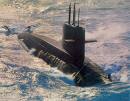|
Royal Netherlands Navy, Dutch Walrus S-802
 As early as the 1960s, a conscious choice was made, by the Dutch Navy, for diesel-electric submarines rather than nuclear-powered vessels. The former can operate with lower noise levels and are thus eminently suitable for their tasks. A further advantage is that the construction and running costs of diesel-electric submarines are considerably lower than those of nuclear-propelled vessels. As early as the 1960s, a conscious choice was made, by the Dutch Navy, for diesel-electric submarines rather than nuclear-powered vessels. The former can operate with lower noise levels and are thus eminently suitable for their tasks. A further advantage is that the construction and running costs of diesel-electric submarines are considerably lower than those of nuclear-propelled vessels.
The Royal Netherlands Navy (RNLN) started the Walrus class project in 1978. It was a project to build a series of four submarines, as a replacement for the four triple-hull submarines of the Dolfine class; a unique Dutch design dating from the fifties which for many years until 1992 determined the face of the Dutch submarine service.The operational range of the RNLN submarines lies mainly in the Eastern Atlantic Ocean, the North Sea and the Norwegian Sea, but also in the Mediterranean. Their missions are directed at anti-surface and anti-submarine warfare, carrying out surveillance, special operations, and the laying of mines.
The design of the boat was under the guidance of the Royal Netherlands Navy. Around 1950 the first class of self-designed submarines emerged. Four triple-hull submarines were delivered to the RNLN in the period 1960-64, Dolfine class. The triple-hull design achieved excellent diving depth with relatively thin steel plating. The development of the present Walrus class stems from a different source, the Albacore, the US test submarine for high speed, forerunner of the nuclear attack submarines as well as their non-nuclear version of the 1960s, the Barbel. The Zwaardvis class submarines were in operation from 1972 to 1995.
At the beginning of the design stage of the Walrus class submarine the RNLN required the reduction of crew-this has been reached, amongst other things, by adopting an extensive automation of not only data-handling, sensors and weapons, but also for platform control.
Since 1988, the four submarines have been sailing all over their operational areas and beyond, proving that the Walrus class submarine is capable of operating all over the world.
Specifications, Walrus S-802, Walrus class:
The Walrus class is a relatively conventional SSK design, laid down October 11, 1979 by RDM (de Rotterdamsche Droogdok Maatschappij, Rotterdam, launched September 13, 1989 and commissioned Mars 25, 1992.The S-802 was firs launched on October 26, 1985 but she caught serious fire in August 86; hull undamaged but cabling and computers destroyed.
Displacement (srf/sub tons): 2,465/2,800
Dimensions (L*B*D feet): 223`1*27`6*23
Propulsion: diesel-electric 3*2,100hp SEMT Pieistick 12 PA4 200 VG diesels, 3 alternators 2.88 MW, 1*6,910hp Holec electric motors, 420 Varta battery cells,1 shaft
Speed (srf/sub knots): 12/20
Range (srf/sub n/miles@knots): snorting 10,000@9 or 7,600@8/380@4 or 230@8
Diving depth (feet): 985
Complement: 7 officers 45 enlisted
Missile: Mc Donnell Douglas Sub Harpoon, sub-launched anti-ship missiles
Torpedo: 4*21" (533 mm) bow torpedo tubes, total of 20 torpedoes or missiles, water-ram discharge
Mines: 40 in lieu of torpedoes
Armament: none
Construction
Based on the two 2600 tons Zwaardvis class boats featuring a full ocean-going operational capability. It is an improved class with similar dimensions and identical silhouettes except for the X-stern rudder system. Use of new H.T. steel increased the diving depth by some 50 percent, a double-hull configuration but of advanced `tear-drop` form. All 4 units of class were commissioned 1990-94.
Back to History Index
 |
Antigua & Barbuda |
2000 |
Dutch Walrus S-802, SSK Walrus class submarine |
|